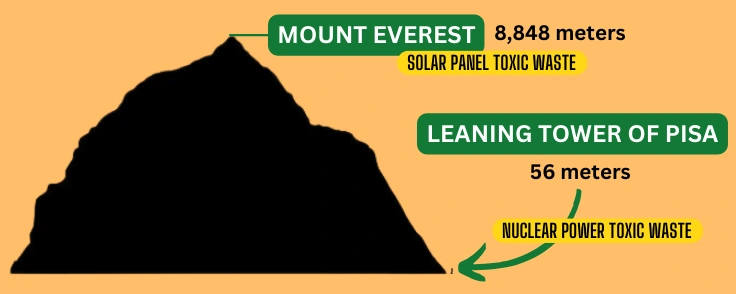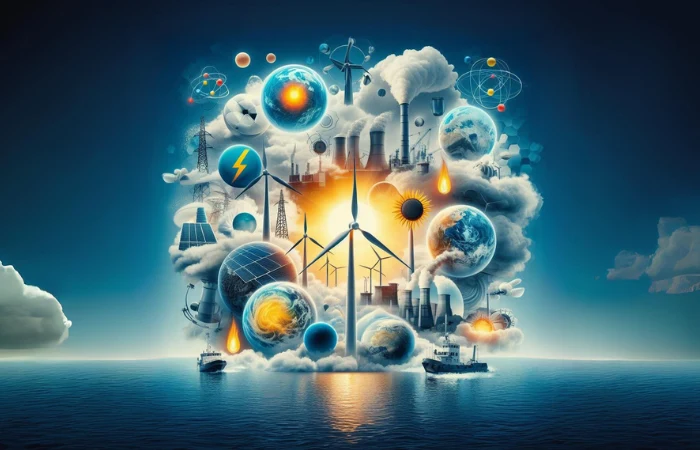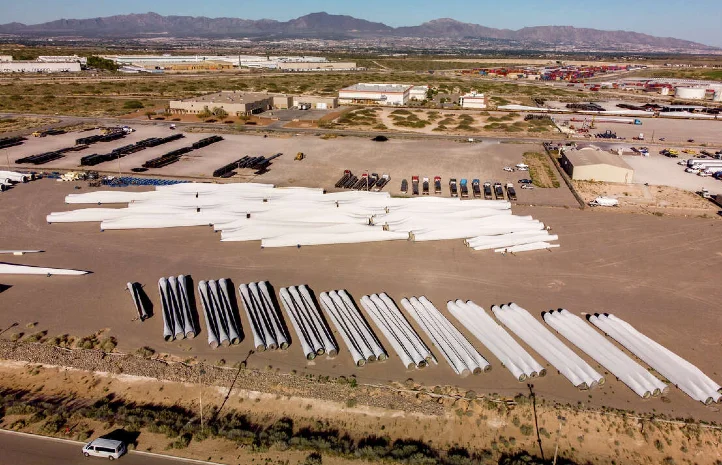The quest for energy is a balancing act between power generation and the preservation of our planet and its inhabitants.
In our search for the ideal energy source, we must weigh the benefits against the potential harm to our environment, our health, and the intricate web of ecology surrounding us. This is a pivotal conversation that shapes not only our present but our future sustainability.
In this article, you’ll learn:
- The safety and ecological profiles of key energy sources.
- How different energy types affect local wildlife and ecosystems.
- The economic and environmental trade-offs involved in energy production.
- Which energy source, according to the numbers, we should be investing in first and foremost.
As we navigate through the complex energy landscape, let’s uncover the truths behind each power source and their impacts that extend far beyond our light switches and power lines.

The Ecological Footprint of Energy Production
When we talk about the energy we use, there’s more to the story than just flipping a switch. Behind every lit-up screen and buzzing appliance is a chain of events that reaches back to natural habitats and the animals living there. The choices we make about the energy we use can help or harm the world around us.
Our planet is a big, interconnected system where everything affects everything else. The energy sources we rely on—like coal, oil, gas, wind, solar, and nuclear—all fit into this system in different ways. Some of them fit in a way that’s rough on nature, while others slide in more gently.
For example, digging up coal or drilling for oil can mess with land and water in big ways, leaving animals and plants in a tough spot. But even the clean energy sources we’re all excited about, like wind and solar, can be tricky. Wind turbines can be a hazard for birds flying by, and vast solar farms can take up space where desert creatures used to live.
Then there’s nuclear power. It’s kind of the quiet one in the corner that doesn’t make a big mess or noise, but it’s super powerful. A lot of folks worry about it because of the disasters they’ve heard about, but in terms of day-to-day running, it’s not causing any trouble for the local critters.
So, when we think about the energy we use, it’s not just about what’s cheapest or what’s going to keep our homes warm. It’s also about asking, “What’s the trade-off for nature?” Because in the long run, taking care of our planet means we’re taking care of our home.
In the dialogue about energy, the term ‘ecological footprint’ is pivotal. It gauges the extent to which energy harvesting and consumption disrupt the delicate equilibrium of our ecosystems. From the vast sweeps of wilderness to the smallest microbial communities, the ripples of our energy choices are felt.
Each joule of energy harnessed carries with it a story of environmental interaction – some are tales of coexistence, while others are of unintended dominance over nature. The ideal energy source would power our civilization with minimal ecological intrusion, yet the reality is a tapestry of complex trade-offs.
- Fossil fuels, while robust in energy delivery, often cast long shadows over ecosystems, leading to habitat loss and species displacement.
- Renewables promise a greener future but aren’t without their ecological costs, such as the unintended harm to avian and aquatic life.
- Nuclear power stands apart, offering a high-energy yield with surprisingly low ecological disruption, challenging many preconceived notions.
Understanding these ecological footprints isn’t just about conservation; it’s about crafting a path forward that honors the interconnectedness of life and the need for sustainable progress.

Fossil Fuels: The Environmental and Ecological Costs
Let’s talk about fossil fuels like coal, oil, and natural gas. They’re kind of like the old-timers of the energy world, and they pack a punch when it comes to power. But they come with a hefty price tag for the planet.
First up, coal. It’s like the heavyweight champion of pollution, belting out around 820 tons of CO2 for every gigawatt-hour of power it produces. That’s a lot of greenhouse gas. And it’s not just the air that gets hit; mining for coal can rip up the land, leaving habitats wrecked and animals without homes.
Oil isn’t much better. For every gigawatt-hour, it’s responsible for about 720 tons of CO2. And when things go wrong, they go really wrong. Remember those oil spills we see on the news? They coat everything in sight, and it can take years for those places to recover, if they ever do.
But there’s something that few people discuss in relation to the oil industry and oil spills. Every decade, the spills drop dramatically as the industry grows and learns and invests in transportation and safety. Solar and wind are still young industries compared to fossil fuels, and they have much still to learn.

Natural gas is a bit cleaner, with 490 tons of CO2 per gigawatt-hour, but it’s still a fossil fuel. It can lead to messed-up water supplies and disturb ecosystems when we drill for it.
Now, for the real talk. These fuels aren’t just about CO2. They can also be deadly. Coal’s responsible for about 25 deaths per terawatt-hour because of air pollution and mining accidents. Oil’s at about 18 deaths, and natural gas is at 3. Those numbers might not seem high, but they add up fast when you think about how much energy we use.
So yeah, fossil fuels have helped us get to where we are today, but they’re kind of like that friend who’s always causing trouble. We need to start looking for better buddies in the energy world if we want to keep our planet—and ourselves—healthy.
Renewable Energy: Balancing Safety with Ecology & A Touch of Greenwashing
Renewable energy, with its roots in sun, wind, and water, is often celebrated as the clean, guilt-free alternative to fossil fuels. However, the environmental narrative for renewables like solar and wind energy is more complex than it first appears, particularly concerning their impact on wildlife and waste management.
Solar energy, for instance, isn’t just about harnessing the power of the sun. The construction of solar farms requires significant land use, often leading to habitat disruption. In desert ecosystems, where solar panels are commonly installed, this can mean displacing native species like tortoises and disrupting the delicate balance of the ecosystem. Beyond habitat disruption, solar panels have been implicated in the deaths of birds and beneficial insects, including pollinators like bees. The glare from the panels can disorient birds, leading to fatal collisions, and the heat generated can be lethal to insects. The end-of-life disposal of solar panels presents another challenge. As panels reach the end of their lifespan, they become a source of waste, with current recycling solutions still in developmental stages.
Wind energy also comes with ecological costs. The spinning blades of wind turbines pose a significant threat to birds and bats, leading to fatalities through collision. This impact isn’t limited to terrestrial environments; offshore wind farms have been linked to disturbances, and death, in marine life, including whales. These installations can disrupt migratory patterns and marine ecosystems. Moreover, the decommissioning of wind turbines raises concerns about waste. The sheer size of the blades makes them difficult to recycle, often leading to landfill disposal.
Hydropower, while responsible for a lower rate of direct wildlife fatalities, isn’t without its environmental impact. The construction of dams for hydropower can lead to flooding, drastically altering local ecosystems and affecting fish populations and their migratory routes.
In summary, while renewable energy sources like solar and wind present a cleaner alternative to fossil fuels in terms of emissions, their impact on wildlife and challenges in waste management are significant issues that need to be addressed. These aspects are often overshadowed in the broader environmental discourse, but are crucial for a holistic understanding of the true cost of our shift towards renewable energy.
Now for the good news: both wind and solar are super safe for us humans. We’re talking fewer than 0.1 deaths per terawatt-hour. And they’re getting better for nature, too, as we find ways to build them with wildlife in mind.
In the big picture, renewables are a step in the right direction. They’re helping us move away from the messy world of fossil fuels. Sure, they’ve got their issues, but the cool part is that we’re learning and improving as we go.
Nuclear Energy: A Controversial Yet Ecologically Tame Giant
Nuclear energy often gets a bad rap. When people hear “nuclear,” they think of disasters and danger. But let’s look at the numbers because they tell a different story.
Here’s a surprising fact: nuclear power is one of the safest energy sources out there in terms of human lives. The data shows less than 0.1 deaths per terawatt-hour. That’s way lower than fossil fuels, and it’s on par with wind and solar. Plus, nuclear power plants don’t take up much space, so they don’t disrupt local ecosystems much.
But what about radiation, right? Modern nuclear plants are designed with safety as a top priority. The technology has come a long way since the early days, and accidents are incredibly rare. Plus, nuclear energy is a champion when it comes to low emissions, producing just 12 tons of CO2 per gigawatt-hour thanks to its high efficiency and zero-emission energy generation.
Another cool point? Nuclear power doesn’t mess with animal habitats. There’s no mining or drilling. The plants sit there quietly, churning out massive amounts of power without sending wildlife packing or causing big spills.
I know what you’re thinking, what about all that nuclear waste? Well, in reality, a nuclear power plant each year doesn’t create much nuclear waste. In fact, the largest nuclear facility on the planet only produces about 18 barrels (42 gallon barrel). Consider that for a moment and compare it to the waste created each year from every other form of energy production – used wind turbines, discarded solar panels, air pollution from coal plants, etc.
In fact, compare the amount of nuclear waste produced each year to the total amount of solar panel toxic waste, and you’ll find yourself comparing the size difference between Mount Everest and the Leaning Tower of Pisa.

And while we must be careful about how we store spent nuclear fuel, the mass hysteria that nuclear waste can leak from the containers is simply unfounded. Those barrels were developed exclusively for nuclear waste, and they’ll hold it all and maintain a tight seal for thousands of years – more than enough time for scientists to discover an alternative use for the waste. In fact, scientists are working on solutions to make even the waste safer and less of a problem right now.
So, nuclear energy might not be as flashy or trendy as solar or wind, but it’s a steady, low-impact workhorse that could help us big time in cutting down carbon emissions and protecting local ecologies.
The True Cost of Energy: Beyond Dollars and Cents
When we pick an energy source, it’s like choosing a meal based on nutrition labels – we’ve got to consider what’s inside. The cost of energy isn’t just about our monthly bills; it’s also about the health of our planet.
Let’s break it down. Coal might seem cheap at the checkout, but it’s like junk food for the planet – full of hidden health hazards. Coal plants are expensive to run and even more costly to clean up after. And oil? It’s like that overpriced snack that promises a lot but leaves a mess behind, especially when it spills.
Natural gas is a bit like fast food – it’s cleaner and quicker, but it’s still not great for long-term health. It’s often seen as a ‘bridge’ fuel, a step away from coal and oil, but it still has its problems, like methane leaks.

Renewable energy is like a home-cooked meal – it takes more effort upfront, but it’s worth it in the long run. The cost of setting up solar panels and wind turbines can be high, but once they’re up, they keep on giving without much extra cost or pollution.
Nuclear is the surprise bargain. High startup costs, sure, but over time, it’s like buying in bulk – you get a lot for what you spend. And with low emissions and a small ecological footprint, it’s a good deal for the environment, too.
The real deal is looking at the lifecycle of these energy sources – from pulling them out of the ground to flipping the off switch. When we add up everything, like the impact on wildlife, health costs from pollution, and the risks of climate change, renewables and nuclear often come out as the best bang for our buck.
Emerging Trends in Energy Sustainability
Energy isn’t just a story about today; it’s about tomorrow, too. What’s exciting is that the energy scene is getting shaken up by some pretty smart ideas and innovations.
Solar and wind power are like the smartphones of energy – they’re getting better and cheaper every year. We’re finding smarter ways to fit them into our lives and landscapes without messing with Mother Nature. For example, solar panels are popping up on rooftops and over parking lots, places where they don’t disturb the local scene.
Unorthodox battery tech is a game-changer, too. It’s like having a savings account for energy; we can store power when there’s extra, like on a super sunny day or a windy night, and use it later. This helps make renewable energy more reliable and lets us keep the lights on even when the sun’s not shining or the wind’s not blowing.
And get this: there’s a buzz about turning CO2 into rock. It’s a wild idea where scientists are figuring out how to take CO2 out of the air and lock it away underground. If it works, it could be a massive help in cleaning up our act.
Then there’s nuclear fusion – it’s like the dream team player we’re all waiting for. If scientists can make it work, it could give us a ton of clean power without the waste problem we have with current nuclear plants.
The future’s looking bright, with loads of people cooking up ideas to make energy cleaner, safer, and friendlier for our planet. It’s all about taking the good stuff we’re doing now and turbocharging it to the next level.
More To Discover
- Swiss Innovation Slashes Radioactive Waste by 80% in Nuclear Plants
- Setback for US Offshore Wind Ambitions as Orsted Halts Major Projects Citing Economic Pressures
- Germany Invests $8 Billion to Rescue Key Green Energy Firm Amid Energy Transition
- Chinese-Made Offshore Wind Energy Farms Are A Dual Threat
Quick Rundown of Energy Sources and Related Data
- Coal
- CO2 Emissions: 820 tons per gigawatt-hour.
- Environmental Impact: Significant habitat destruction and species displacement.
- Human Health: Around 25 deaths per terawatt-hour from pollution and mining accidents.
- Oil
- CO2 Emissions: 720 tons per gigawatt-hour.
- Environmental Impact: Risk of oil spills causing long-term ecological damage.
- Human Health: Responsible for 18 annual deaths per terawatt-hour.
- Natural Gas
- CO2 Emissions: 490 tons per gigawatt-hour.
- Environmental Impact: Water contamination and ecosystem disruption from drilling.
- Human Health: Causes 3 annual deaths per terawatt-hour.
- Solar Energy
- CO2 Emissions: Low, but production and disposal have environmental costs.
- Environmental Impact: Habitat disruption, bird, and insect fatalities.
- Waste Management: Challenges in recycling end-of-life solar panels.
- Wind Energy
- CO2 Emissions: Low and considered one of the cleanest.
- Environmental Impact: Bird and bat fatalities; offshore turbines affect marine life.
- Waste Management: Difficulty in recycling large turbine blades.
- Nuclear Energy
- CO2 Emissions: 12 tons per gigawatt-hour, extremely low.
- Environmental Impact: Minimal habitat disruption; concerns focus on waste management.
- Human Health: Less than 0.1 deaths per terawatt-hour, surprisingly safe.
- Hydropower
- Environmental Impact: Alters water ecosystems, affecting fish and other aquatic life.
- Human Health: One death per terawatt-hour, primarily due to dam failures.
In our journey through the world of energy, we’ve seen that each source has its own story. From the old guard of coal, oil, and natural gas, to the new wave of renewables and the steady power of nuclear, it’s clear that there’s no one-size-fits-all answer. Every choice has its trade-offs, whether it’s the environmental toll of fossil fuels, the wildlife impacts of renewables, or the waste challenges of nuclear.
But here’s the real takeaway: we’re not stuck with the energy sources of the past. Innovations in technology, improvements in storage, and creative solutions to environmental challenges are opening up a world of possibilities. We’re learning to balance our need for power with the need to protect our planet and its inhabitants.
As we move forward, the key will be in finding that balance. It’s about choosing the energy sources that not only keep our lights on and our homes warm, but also safeguard our environment and the creatures we share it with.
And that’s where you come in. You have the power to influence the future of energy – by staying informed, advocating for sustainable choices, and maybe even adjusting a few of your own energy habits. Together, we can steer towards a cleaner, greener future.
For those intrigued by the evolving energy landscape, a natural next step is diving deeper into how these energy sources can be integrated into our daily lives sustainably. Exploring topics like virtual power plants, energy efficiency in homes and businesses or the role of policy in shaping our energy future could be your next adventure in understanding and contributing to a sustainable world.























